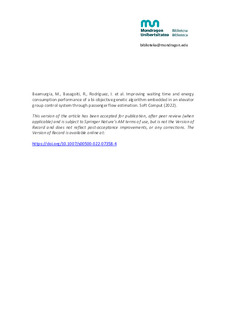Título
Improving Waiting Time and Energy Consumption Performance of a Bi- objective Genetic Algorithm embedded in an Elevator Group Control System through passenger flow estimationAutor-a
Fecha de publicación
2022Otras instituciones
Fagor AOTEKUniversidad de Navarra
Versión
PostprintTipo de documento
ArtículoArtículoIdioma
InglésDerechos
The Author(s), under exclusive licence to Springer-Verlag GmbH Germany, part of Springer Nature 2022Acceso
Acceso embargadoFin de la fecha de embargo
2023-08-31Versión de la editorial
https://doi.org/10.1007/s00500-022-07358-4Publicado en
Soft Computing 2022. First online 07 August 2022Editorial
SpringerPalabras clave
Genetic algorithmElevator dispatching problem
Passenger Flow Patterns
Transportation
Resumen
Passenger waiting time is a significant issue related to the quality of service of a multiple lift system; however, energy consumption reduction is also an important concern in the lift industry. In t ... [+]
Passenger waiting time is a significant issue related to the quality of service of a multiple lift system; however, energy consumption reduction is also an important concern in the lift industry. In this paper, we evaluate different versions of a genetic algorithm (GA) published previously by the authors with several relevant adjustments for the lift dispatching problem to minimize passenger waiting time and/or energy consumption. To the raw GA with adjustments (that works under the assumption one call-one passenger) we incorporated several elements: a passenger-counting module using origin-destination (OD) matrices, and the activation of certain policies (zoning and/or parking) under different detected traffic profiles (up-peak, interfloor or down-peak profiles). Besides, we added a proportional integral controller (PI) to assign different weights to passenger waiting time and energy consumption to evaluate the performance of our GA. Different versions of this GA, minimizing passenger waiting time and/or energy consumption, were compared among them and to a conventional control algorithm using three different types of simulated profiles: a mixed one, three well-known full day office profiles, and three different step profiles. The results showed that the bi-objective GA version with the estimation of the number of passengers behind a call, i.e., the passenger forecasting, together with the parking policy for up-peak or down peak conditions significantly improved performance of passenger waiting time, and in some cases in energy consumption as well. The addition of the PI controller to the GA proved to be especially useful when the system was under a high intensity traffic demand. The advantages of all these elements to forecast the passenger flow and detect the traffic profile to help the controller shows unquestionable benefits to minimize passenger waiting time and energy consumption. [-]
Sponsorship
Gobierno VascoID Proyecto
info:eu-repo/grantAgreement/GV/Ikertalde Convocatoria 2022-2025/IT1676-22/CAPV/Sistemas Inteligentes para Sistemas Industriales/Colecciones
- Artículos - Ingeniería [761]





















